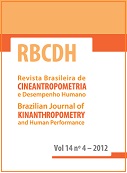Noncircular chainrings and pedal to crank interface in cycling: a literature review.
DOI:
https://doi.org/10.1590/1980-0037.2012v14n4p470Abstract
Noncircular chainrings and novel pedal to crank interfaces have been designed to optimize variables related to cycling performance (e.g. peak crank torque and efficiency), with conflicting results in terms of performance. Therefore, the aim of the present article was to review the theoretical background of noncircular chainrings and novel pedal to crank interfaces and their effects on biomechanical, physiological and performance variables. Reducing internal work, crank peak torque, and time spent at the top and bottom dead centres (12 o’clock and 6 o’clock positions, respectively) were among the various targets of noncircular chainrings and novel pedal to crank interface design. Changes in joint kinematics without effects on muscle activation were observed when cyclists were assessed using noncircular chainrings and novel pedal to crank interfaces. Conflicting results for economy/efficiency explain the unclear effects of noncircular chainrings on cycling performance and the positive effects of some novel pedal to crank interfaces on cycling economy/efficiency.



